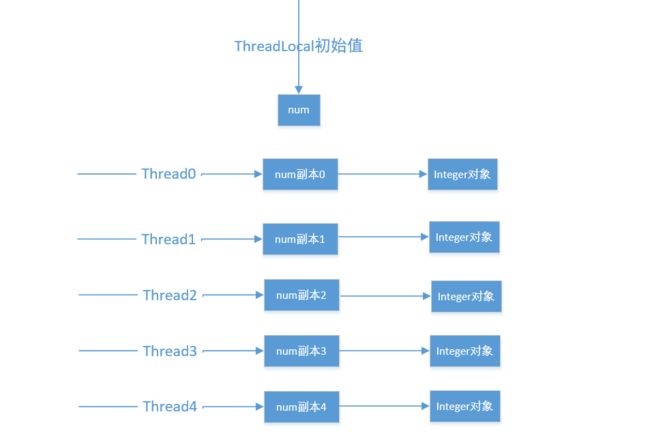转载请注明文章出处LooperJing!
在上篇文章Android源码解析Handler系列第(一)篇说了Message的内部维持的全局池机制。这一篇仍然是准备知识,因为在Handler中有ThreadLocal的身影,大家知道,Handler创建的时候会采用当前线程的Looper来构造消息循环系统,那么Handler内部如何获取到当前线程的Looper呢?这就要使用ThreadLocal了,ThreadLocal可以在不同的线程之中互不干扰地存储并提供数据,通过ThreadLocal可以轻松获取每个线程的Looper,所以,ThreadLocal是理解Looper的关键之一。
先看一下官方对这个类的解释
/**
* Implements a thread-local storage, that is, a variable for which each thread
* has its own value. All threads share the same {@code ThreadLocal} object,
* but each sees a different value when accessing it, and changes made by one
* thread do not affect the other threads. The implementation supports
* {@code null} values.
*
* @see java.lang.Thread
* @author Bob Lee
*/
大概意思就是说:实现了一个线程本地存储,也就是说,每个线程的一个变量,有自己的值。所有线程共享同一个 ThreadLocal对象,但每个线程访问它时,看到一个不同的值,如果一个线程改变了这个值,不影响其他线程,ThreadLocal支持NULL值。理解好费劲,只能说我翻译的太差!
重新解释一下:当工作于多线程中的对象使用ThreadLocal 维护变量时,ThreadLocal 为 每个使用该变量的线程分配一个独立的变量副本。每个线程独立改变自己的副本,而不影响其他线程所对应的变量副本。这就是它的基本原理,ThreadLocal主要的 API很简单。
public void set(T value):将值放入线程局部变量中
public T get():从线程局部变量中获取值
public void remove():从线程局部变量中移除值(有助于 JVM 垃圾回收)
protected T initialValue():返回线程局部变量中的初始值(默认为 null)
ThreadLocal为各个线程保存一个变量副本,这句话是关键,怎么理解?先来一个简单的DEMO
public class ThreadLocalTest {
public static void main(String[] args) throws InterruptedException {
ThreadLocal mBooleanThreadLocal=new ThreadLocal(){
@Override
protected Boolean initialValue() {
//初始值是false
return false;
}
};
mBooleanThreadLocal.set(true);
System.out.println("[Thread#main]mBooleanThreadLocal=" +mBooleanThreadLocal.hashCode()+" "+ mBooleanThreadLocal.get());
new Thread("Thread#1") {
@Override
public void run() {
mBooleanThreadLocal.set(false);
System.out.println( "[Thread#1]mBooleanThreadLocal="+mBooleanThreadLocal.hashCode() +" "+ mBooleanThreadLocal.get());
};
}.start();
new Thread("Thread#2") {
@Override
public void run() {
System.out.println( "[Thread#2]mBooleanThreadLocal="+mBooleanThreadLocal.hashCode() + " "+mBooleanThreadLocal.get());
};
}.start();
}
}
输出结果:
[Thread#main]mBooleanThreadLocal=366712642 true
[Thread#1]mBooleanThreadLocal=366712642 false
[Thread#2]mBooleanThreadLocal=366712642 false
在上面的代码中,在主线程中设置mBooleanThreadLocal的值为true,在子线程1中设置mBooleanThreadLocal的值为false,在子线程2中不设置mBooleanThreadLocal的值,然后分别在3个线程中通过get方法去mBooleanThreadLocal的值,所以,主线程中应该是true,子线程1中应该是false,而子线程2中由于没有设置值,所以应该是初始值false。
再看一个DEMO
public class ThreadLocalTest {
//创建一个Integer型的线程本地变量
public static final ThreadLocal local = new ThreadLocal() {
@Override
protected Integer initialValue() {
return 0;
}
};
public static void main(String[] args) throws InterruptedException {
Thread[] threads = new Thread[5];
for (int j = 0; j < 5; j++) {
threads[j] = new Thread(new Runnable() {
@Override
public void run() {
//获取当前线程的本地变量,然后累加5次
int num = local.get();
for (int i = 0; i < 5; i++) {
num++;
}
//重新设置累加后的本地变量
local.set(num);
System.out.println(Thread.currentThread().getName() + " : "+ local.get());
}
}, "Thread-" + j);
}
for (Thread thread : threads) {
thread.start();
}
}
}
输出结果:
Thread-1 : 5
Thread-3 : 5
Thread-4 : 5
Thread-0 : 5
Thread-2 : 5
开了5个线程,每个线程累加后的结果都是5,各个线程处理自己的本地变量值,线程之间互不影响。
读到这里,相信你对ThreadLocal的作用已经了解了,ThreadLocal和synchronized是有区别的,概括起来说,对于多线程资源共享的问题,同步机制采用了“以时间换空间”的方式,而ThreadLocal采用了“以空间换时间”的方式。前者仅提供一份变量,让不同的线程排队访问,而后者为每一个线程都提供了一份变量,因此可以同时访问而互不影响,所以ThreadLocal和synchronized都能保证线程安全,但是应用场景却大不一样。
现在从源码中去找找答案,为什么各个线程都能保留一份副本,做到多并发的时候,线程互不影响呢?
ThreadLocal的构造函数是空的,啥也没有。
public ThreadLocal() {
}
看一下里面的set方法
/**
* Sets the value of this variable for the current thread. If set to
* {@code null}, the value will be set to null and the underlying entry will
* still be present.
*
* @param value the new value of the variable for the caller thread.
*/
public void set(T value) {
Thread currentThread = Thread.currentThread();
Values values = values(currentThread);
if (values == null) {
values = initializeValues(currentThread);
}
values.put(this, value);
}
首先获得了当前线程实例,将实例传入values方法中,获得一个Values对象,第一次获得的Values对象是空的,就调用initializeValues初始化一个values对象,最后把当前对象作为key,value作为值,放进values中。现在的重点就是搞懂Values是什么?Values原来是ThreadLocal的静态内部类。在ThreadLocal.Values中有一个table成员,而这个table就以key,value的形式存储了线程的本地变量。key是ThreadLocal
/**
* 存放数据的数组。他存放数据的形式有点像map,是ThreadLocal与value相对应, 长度总是2的N次方
*/
private Object[] table;
Value的主要API有下面几个
- void put(ThreadLocal key, Object value):往table里添加一个键值对
- void add(ThreadLocal key, Object value):也是往table里面添加键值对
- Object getAfterMiss(ThreadLocal key):在首位置没找到值的时候通过这个方法来找到给定key的值
-
void remove(ThreadLocal key):删掉给定key对应的值
Values是调用put方法把传进来的键值对给存到table表里面去,这里不去分析它是怎么实现的了(可以移步http://blog.csdn.net/luoyanglizi/article/details/51510233)
/**
* Sets entry for given ThreadLocal to given value, creating an
* entry if necessary.
*/
void put(ThreadLocal key, Object value) {
cleanUp();
// Keep track of first tombstone. That's where we want to go back
// and add an entry if necessary.
int firstTombstone = -1;
for (int index = key.hash & mask;; index = next(index)) {
Object k = table[index];
if (k == key.reference) {
// Replace existing entry.
table[index + 1] = value;
return;
}
if (k == null) {
if (firstTombstone == -1) {
// Fill in null slot.
table[index] = key.reference;
table[index + 1] = value;
size++;
return;
}
// Go back and replace first tombstone.
table[firstTombstone] = key.reference;
table[firstTombstone + 1] = value;
tombstones--;
size++;
return;
}
// Remember first tombstone.
if (firstTombstone == -1 && k == TOMBSTONE) {
firstTombstone = index;
}
}
}
上面是ThreadLocal存的过程,现在看取的过程。
/**
* Returns the value of this variable for the current thread. If an entry
* doesn't yet exist for this variable on this thread, this method will
* create an entry, populating the value with the result of
* {@link #initialValue()}.
*
* @return the current value of the variable for the calling thread.
*/
@SuppressWarnings("unchecked")
public T get() {
// Optimized for the fast path.
Thread currentThread = Thread.currentThread();
Values values = values(currentThread);
if (values != null) {
Object[] table = values.table;
int index = hash & values.mask;
if (this.reference == table[index]) {
return (T) table[index + 1];
}
} else {
values = initializeValues(currentThread);
}
return (T) values.getAfterMiss(this);
}
首先取出当前线程的Values对象,跟set方法一样,如果这个对象为null那么就返回初始值, 如果Values对象不为null,那就取出它的table数组并找出ThreadLocal的reference对象在table数组中的位置,然后table数组中的下一个位置所存储的数据就是ThreadLocal的值。从可以看出,ThreadLocal的set和get方法所操作的对象都是当前线程的Values对象的table数组,如果一个变量使用了ThreadLocal,通过ThreadLocal的set和get方法,每一个线程的都会有一份这个变量的副本(键值对的形式进行存取),这就是为什么多线程并发的时候,线程互不影响的操作一个变量。
最后在举一个ThreadLocal的应用的例子:JDBC连接mysql数据库,把 Connection 放到了 ThreadLocal 中,这样每个线程之间就隔离了,不会相互干扰。
public class DBUtil {
// 数据库配置
private static final String driver = "com.mysql.jdbc.Driver";
private static final String url = "jdbc:mysql://localhost:3306/demo";
private static final String username = "xxx";
private static final String password = "xxx";
// 定义一个用于放置数据库连接的局部线程变量(使每个线程都拥有自己的连接)
private static ThreadLocal connContainer = new ThreadLocal();
// 获取连接
public static Connection getConnection() {
Connection conn = connContainer.get();
try {
if (conn == null) {
Class.forName(driver);
conn = DriverManager.getConnection(url, username, password);
}
} catch (Exception e) {
e.printStackTrace();
} finally {
connContainer.set(conn);
}
return conn;
}
// 关闭连接
public static void closeConnection() {
Connection conn = connContainer.get();
try {
if (conn != null) {
conn.close();
}
} catch (Exception e) {
e.printStackTrace();
} finally {
connContainer.remove();
}
}
}
Please accept mybest wishes for your happiness and success
参考链接:
https://my.oschina.net/clopopo/blog/149368
http://blog.csdn.net/singwhatiwanna/article/details/48350919
https://my.oschina.net/huangyong/blog/159725


